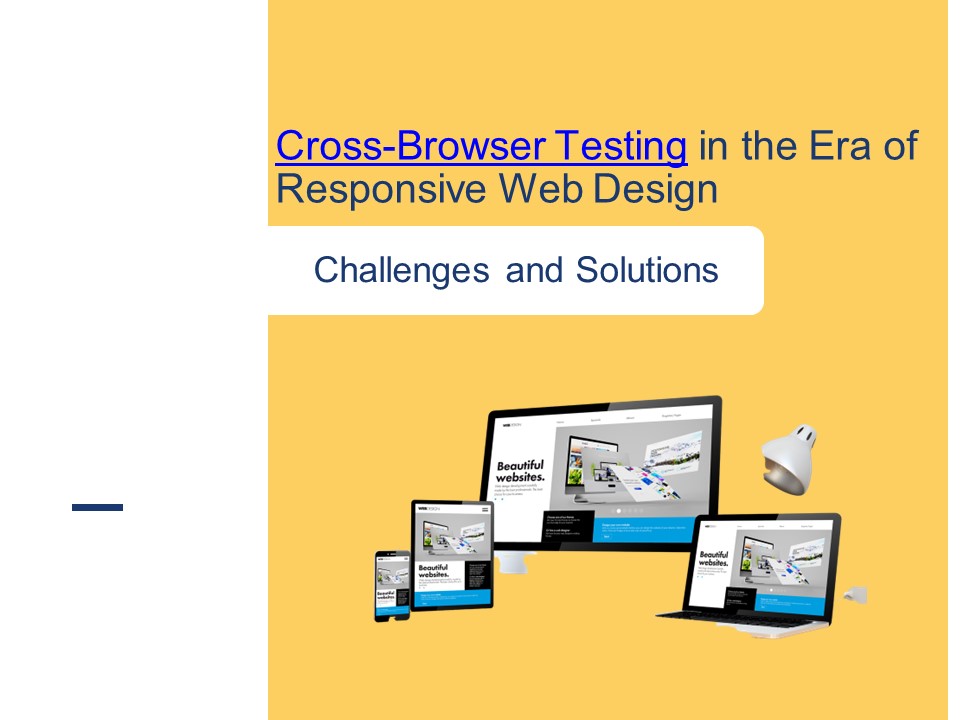Cross-Browser Testing in the Era of Responsive Web Design PowerPoint PPT Presentation
Title: Cross-Browser Testing in the Era of Responsive Web Design
1
Cross-Browser Testing in the Era of Responsive
Web Design
Challenges and Solutions
2
INTRODUCTION
Today, we find ourselves navigating an
increasingly complex digital landscape, where the
diversity of devices and web browsers used by
consumers is more varied than ever before. As web
developers and designers, we strive to create
online experiences that are not only visually
appealing but also functional and accessible
across a multitude of platforms. This is where
the confluence of two crucial aspects of web
development comes into play responsive web
design and cross-browser testing.
3
CHALLENGES
Challenges in Cross-Browser Testing
Cross-browser testing, in the context of web
development, presents a set of unique challenges
that developers and QA professionals must
navigate to ensure a consistent and functional
user experience across different web browsers.
These challenges include
4
Browser Fragmentation One of the primary
challenges is the sheer number of web browsers
available, each with its rendering engine and
version. Popular browsers like Google Chrome,
Mozilla Firefox, Microsoft Edge, Safari, and
Opera, along with their various versions, demand
thorough testing. Device Diversity With the
proliferation of smartphones, tablets, laptops,
and desktop computers, ensuring compatibility
across different devices and screen sizes becomes
crucial. Mobile browsers introduce additional
complexities due to variations in touch
interactions and screen resolutions. Operating
System Variations Browsers often behave
differently on different operating systems (e.g.,
Windows, macOS, Android, iOS). This necessitates
testing on multiple operating systems to identify
and resolve compatibility issues. Browser
Features and Support Browsers have varying
levels of support for HTML, CSS, and JavaScript
standards. Compatibility issues arise when a web
application relies on features or technologies
that are not universally supported.
5
Performance Differences Browsers differ in terms
of performance, speed, and memory consumption.
Optimizing a website's performance to ensure
smooth user interactions across various browsers
is a constant challenge. Security Concerns
Security vulnerabilities can vary from one
browser to another. Developers must address
security concerns unique to each browser to
safeguard user data and privacy. Legacy
Browsers Many users continue to use older
browsers that lack support for modern web
standards. Supporting these legacy browsers can
be resource-intensive and may limit the use of
advanced features. Third-party Dependencies Web
applications often rely on third-party libraries,
plugins, or APIs. Compatibility issues with these
external components can disrupt a site's
functionality. User Accessibility Ensuring web
accessibility for users with disabilities across
different browsers is essential. Compatibility
with screen readers and keyboard navigation is a
critical aspect of cross-browser testing.
6
SOLUTIONS TO OVERCOME CHALLANGES
In the complex world of cross-browser testing,
developers and quality assurance teams face
various challenges. Fortunately, there are
effective solutions available to help overcome
these hurdles and ensure a seamless user
experience across different browsers and devices.
Here are some key solutions
Browser Compatibility Tools Utilize browser
compatibility testing tools such as BrowserStack,
CrossBrowserTesting, or Sauce Labs. These
platforms provide a range of browsers and
operating systems for testing, making it easier
to identify and resolve compatibility issues.
Responsive Design Frameworks Leverage responsive
design frameworks like Bootstrap, Foundation, or
Materialize. These frameworks offer pre-built,
mobile-first design components and layouts,
helping developers create responsive web
applications that adapt to different screen sizes
and devices.
7
Progressive Enhancement and Graceful Degradation
Implement progressive enhancement and graceful
degradation techniques. Start with a basic,
universally supported version of your website and
gradually add advanced features for modern
browsers, ensuring core functionality remains
intact for older or less capable
browsers. Automated Testing Tools Employ
automated testing tools such as Selenium,
Cypress, or Puppeteer. Automation helps
streamline testing processes, ensuring consistent
and repeatable tests across various browsers and
devices, saving time and effort. Feature
Detection Adopt feature detection instead of
browser detection. Check for the availability of
specific features or APIs in browsers before
using them. This approach allows you to provide
fallbacks or alternative solutions when a feature
is not supported. Cross-Browser CSS and
JavaScript Libraries Utilize cross-browser CSS
and JavaScript libraries like Modernizr and
Normalize.css. These libraries help standardize
the behavior and appearance of web elements
across different browsers.
8
Regularly Update Your Testing Matrix Maintain an
up-to-date testing matrix that includes the
latest browser versions and devices used by your
target audience. Regularly review and update this
matrix to adapt to changing user trends and
browser releases. Performance Optimization
Implement performance optimization techniques to
ensure that your web application loads quickly
and runs smoothly across various browsers. This
includes optimizing images, minimizing HTTP
requests, and reducing unnecessary code. User
Agent Testing Test with different user agents to
simulate how your web application behaves on
various devices. This helps identify and address
issues specific to mobile or desktop users. Web
Accessibility Testing Prioritize web
accessibility by using tools like aXe or WAVE to
test your website's compliance with accessibility
standards (e.g., WCAG). Ensure that users with
disabilities can access and interact with your
site effectively. By incorporating these
solutions into your web development and testing
processes, you can tackle the challenges of
cross-browser testing effectively, deliver a
consistent user experience, and reach a broader
audience, regardless of their choice of browser
or device.
9
(No Transcript)

